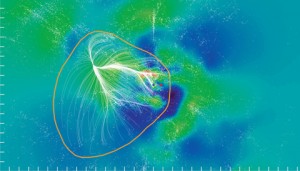Measurements of thousands of galaxies’ motions toward and away from us reveal that the Milky Way sits on the edge of the gigantic Laniakea supercluster of galaxies.

Credit: SDvision interactive visualization software by DP at CEA/Saclay, France
Astronomers have mapped the cosmic watershed in which our Milky Way Galaxy is a droplet. The massive structure, which the research team dubs the Laniakea Supercluster, extends more than 500 million light-years and contains 100,000 large galaxies.
The work, published in the September 4th Nature, is the first to trace our local supercluster on such a large scale. It also provides a physical way to define what a supercluster actually is.
Researchers have been working out the gravitational structure in our local universe for decades. Based on work by Gerard de Vaucouleurs in the 1950s, astronomers have thought of our galaxy as being on the edge of the so-called Local Supercluster, a structure about 100 million light-years wide that’s centered on the Virgo Cluster of galaxies.
But astronomers have also seen much larger structures in the universe, on the scale of several hundred million light-years, thanks to the Sloan Digital Sky Survey and other work. These maps have generally depended on calculating galaxies’ 3-D locations based on the galaxies’ cosmological redshifts, the shift in a galaxy’s spectral lines due to the galaxy’s apparent motion as the universe itself expands.
Brent Tully (University of Hawaii, Honolulu) and colleagues have taken a different approach. They used galaxies’ peculiar velocities, which are the galaxies’ motions due to the local gravitational landscape. Galaxies fall toward or away from one another in this landscape; the Milky Way and many others seem to be moving toward what’s called the Great Attractor, a dense region in the vicinity of the Centaurus, Norma, and Hydra clusters about 160 million light-years away.
Peculiar velocities are on the order of a few hundred kilometers per second, whereas the cosmic expansion velocities rise to 10,000 km/s roughly 400 million light-years away. (Due to the nature of cosmic expansion, a galaxy recedes faster the farther away it is.) There’s about 10-20% uncertainty in the peculiar velocity measurement for an individual galaxy, says Tully. So only for nearby galaxies is an individual system’s peculiar velocity high enough compared with its expansion velocity for astronomers to peg it confidently. Farther out, the data are sparser.
But the team found a way around this problem by using an analysis technique called Wiener filtering. This algorithm allowed the team to essentially take a step back and look at the big picture, revealing the large-scale flow patterns created by galaxies’ motions. With this wide-field view, the individual uncertainties don’t matter so much.
Last year, the team used this technique to map the local universe’s web of filaments, clusters, and voids, creating a fascinating video simulation of the flow patterns in the gravitational watershed. Now, they’ve taken a closer look using their Cosmicflows-2 catalog, which contains more than 8,100 galaxies. The new catalog reveals where the flows merge and diverge, unveiling a gargantuan structure on whose periphery the Milky Way sits. The Great Attractor is a central valley in this newly demarcated watershed.
The team calls this huge supercluster Laniakea, from the Hawaiian lani (heaven) + akea (spacious, immeasurable).
The analysis also reveals other structures, including a separate supercluster called Perseus-Pisces and a distant concentration named Shapley, which lies about 650 million light-years away and toward which Laniakea is moving.
The team put together an intro video:
Cosmologist Elmo Tempel (Tartu Observatory, Estonia) says that, due to the nature of the analysis, he’s confident that the Laniakea structure exists. “However, the exact boundaries of Laniakea are not so well established, and they may change if more measurements are carried out,” he cautions.
Because stringent distance measurements (on which the peculiar velocity calculations depend) are much rarer beyond about 300 million light-years, it’s hard to make out what’s going on out there. Given that Laniakea is moving toward Shapley, our supercluster might indeed be only the trunk of the elephant, Tully says. For now, all he and his colleagues can say is that they’ve isolated a “local basin of gravitational attraction.” Finding out whether it’s an appendage of something larger will require accurate distance measurements that reach three times farther than the current catalog.
Nature has also created an in-depth video on the discovery, which I recommend watching.
References:
R. B. Tully et al. “The Laniakea supercluster of galaxies.” Nature. September 4, 2014.
H. M. Courtois et al. “Cosmography of the Local Universe.” Astronomical Journal. September 2013.
Explore the galaxies in our local universe with our ebook Summer Deep Sky.
 1
1









Comments
Anthony Barreiro
September 3, 2014 at 7:28 pm
Thanks for this fascinating report! The videos are quite helpful in visualizing Laniakea in three dimensions. This seven-minute video by the research team, http://vimeo.com/104910552 , provides more background information on the current publication.
It looks like Laniakea fills most of the sky. And to extend the watershed metaphor, our Milky Way galaxy sits near the ridgeline of the continental divide between our supercluster and the neighboring Perseus-Pisces supercluster. That's pretty cool.
You must be logged in to post a comment.
You must be logged in to post a comment.